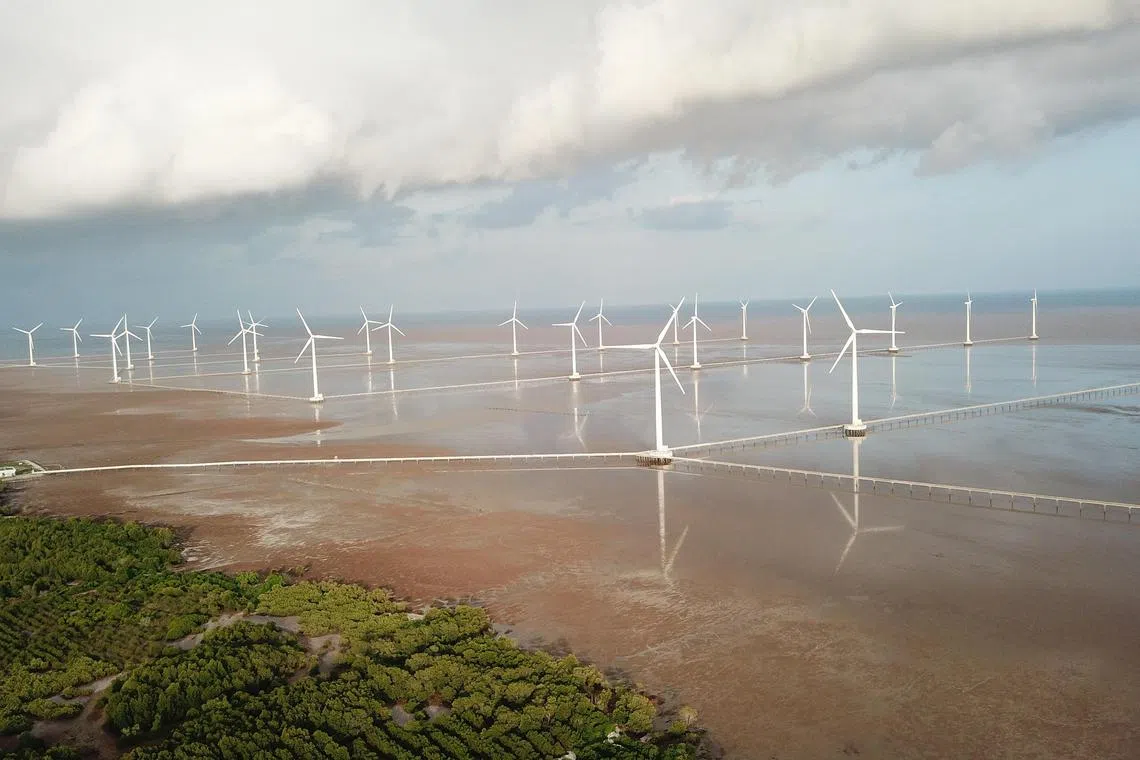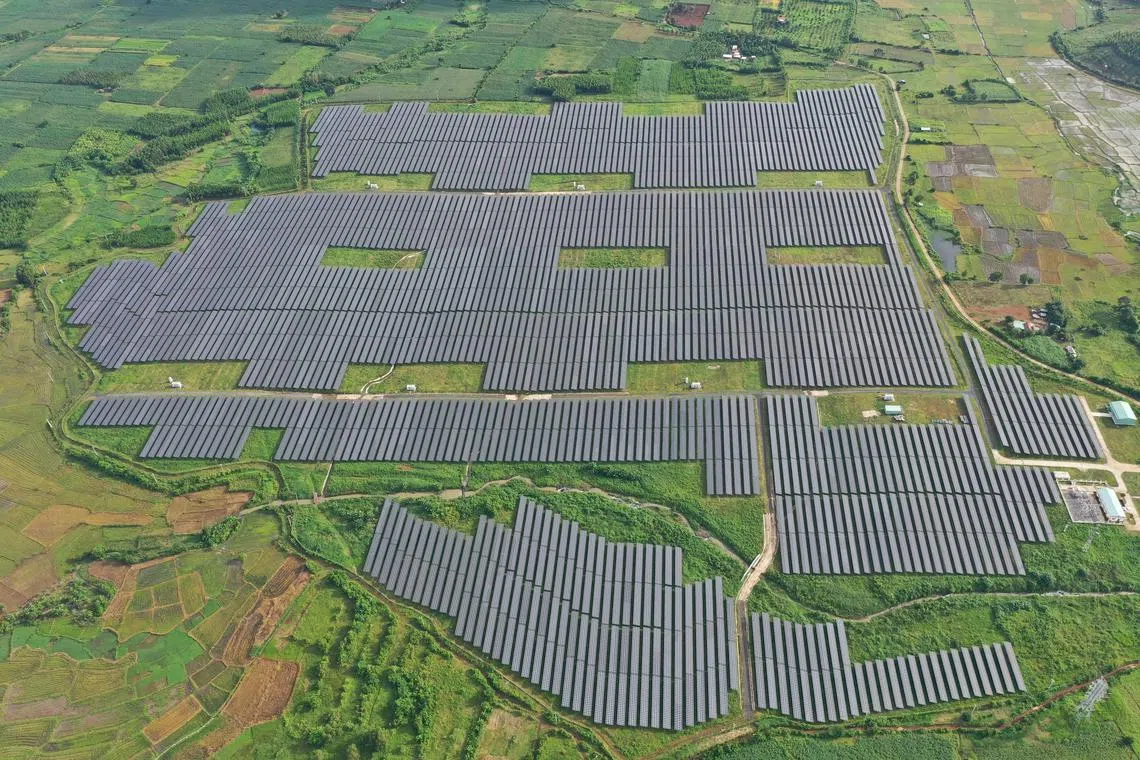Gas investments in South-east Asia undermine green energy, climate push: Report
Sign up now: Get ST's newsletters delivered to your inbox

Plans for a massive build-out of gas-fired power plants and liquefied natural gas terminals in South-east Asia risks locking in decades of costly polluting energy.
PHOTO: ST FILE
Follow topic:
SINGAPORE – South-east Asia faces a major energy conundrum – ramp up the switch to natural gas from polluting coal to meet growing energy needs, or go all in and back cleaner renewables like solar and wind.
Right now, gas seems to be winning, according to an analysis of investment plans published on May 30, which says the dash for gas comes with considerable economic and climate risks.
Plans for a massive build-out of gas-fired power plants and liquefied natural gas (LNG) terminals in South-east Asia risks locking in decades of costly polluting energy and holding back investments in cheaper renewables, says the analysis by US non-profit Global Energy Monitor (Gem), which tracks fossil fuel and renewable energy projects worldwide.
The US$220 billion (S$297 billion) in planned spending could double the region’s gas-fired power capacity and boost LNG import capacity by 80 per cent.
Regional governments say such investments will boost energy security, but critics say they will deepen dependency on costly and volatile gas prices and undermine regional climate plans to cut planet-warming greenhouse gas emissions.
Vietnam, the Philippines, Indonesia, Malaysia and Thailand are at the forefront of the gas push, the study said, and financial backers include Japan and South Korea.
“These gas projects could lock South-east Asian countries into relying on an economically volatile and insecure fuel source,” said the report’s lead author Warda Ajaz, project manager of Gem’s Asia Gas Tracker.
Spot LNG prices hit a record US$70 per metric million British thermal units (mmBtu) in August 2022, following Russia’s invasion of Ukraine, pricing some Asia buyers out of the market as wealthier European nations snapped up LNG cargoes. Spot prices are currently around US$12 per mmBtu.
Data from Gem’s Asia Gas Tracker shows more than 100GW of gas power capacity in development – projects that have been announced or are in the pre-construction and construction phases – together with 47 million tonnes per annum (mtpa) of LNG import capacity and 16.7mtpa of export capacity. The region is a major gas producer and importer.
LNG is more expensive compared with domestic gas produced in the region, said Mr Putra Adhiguna, managing director of the Energy Shift Institute think-tank, which focuses on Asia’s energy transition.
“Cost-sensitive South-east Asian countries focusing too much on LNG-based power while under-exploring their renewables and power grid investment is a slippery slope,” he told The Straits Times.
He said gas power projects are facing more scrutiny on their economics and climate impacts. And the cost of expensive LNG – and electricity – will have to be borne by consumers or the government.
The energy security tussle reflects South-east Asia’s challenge in supplying sufficient energy to meet the needs of its rapidly growing economies and lift millions out of poverty.
The region is expected to have the second-highest energy demand growth in the world after India until 2050, the report says. Fossil fuels remain the dominant source of energy.
The study says green energy projects in the pipeline in South-east Asia could match nearly two-thirds of the region’s projected energy demand increase for 2030 and that shifting investment dollars to renewables could place the region on a more secure energy and climate footing.
It adds that there are about 72GW of solar and 150GW of wind power projects in the pipeline, with no guarantee that all of this will be built.
This project pipeline represents a fraction of the green energy the region could theoretically produce.
The US government’s National Renewable Energy Laboratory estimates the region has 30,523GW of solar and 1,383GW of wind power generation potential – vastly more than current planned gas power additions.
And, while gas produces less pollution than coal when burned, it is not as clean as what some governments and energy companies claim. The total life cycle greenhouse gas emissions of LNG are high.

Green energy projects in the pipeline in South-east Asia could match nearly two-thirds of the region’s projected energy demand increase for 2030. Pictured is the Bac Lieu wind farm Vietnam’s in Nha Mat Ward.
PHOTO: CHI QUOC FOR THE STRAITS TIMES
“Gas’ reputation as a cleaner fuel source continues to go up in smoke as more emissions data comes to light,” Dr Ajaz told ST.
She said methane, the main component of natural gas, leaks into the air at all stages of the gas life cycle during production and consumption.
Methane is a far more potent greenhouse gas than carbon dioxide (CO2), trapping about 80 times as much heat as CO2 over a 20-year timeframe. Chilling and compressing the gas to make it a liquid for transport on ships also consume a lot of energy.
Despite the climate and financial risks, funding continues to flow towards LNG projects in the region and major supplying nations, such as Australia, the US and Qatar.
Mr Putra said one problem was the short-term thinking of governments and utilities. Renewable energy projects have high upfront costs for equipment and grid upgrades, but low ongoing costs.
“Thus, although renewables can be more cost-effective in the medium term, the incentives for executives and the authorities might not extend that far.”

The Thanh Long Phu Yen Solar Power Plant in Phu Yen, a province in the south-central coast of Vietnam.
PHOTO: SP GROUP
Other key drivers include the influence of established fossil fuel players and international pressure and financing from countries including Japan and South Korea to offload excess LNG supplies.
LNG use is declining in Japan and South Korea. But because they are locked in long-term supply contracts, they need to on-sell LNG shipments.
For example, Japan resells more LNG overseas than it imports from Australia, according to a May 17 report by the Institute for Energy Economics and Financial Analysis, a US think-tank.
The surplus LNG is often sold in South-east Asia, where Japanese utilities are cultivating demand, the report said.


